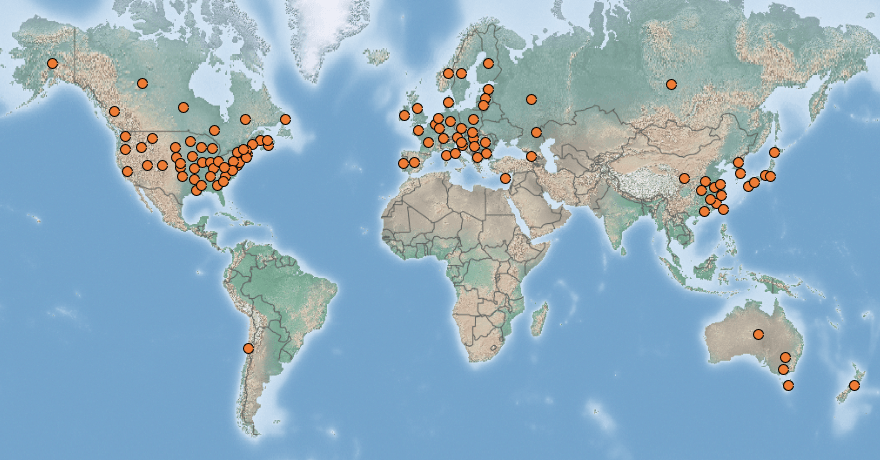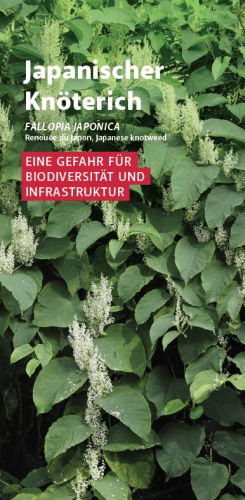 |
Japanese Knotweed | Status LU: established. 1st record: LU 1849, ITW <1872. |
 |
Japanescht Knuetkraut | Status Eur.: established. 1st record: NL 1847. |
 |
Renouée du Japon, renouée bambou | RA: ISEIA: A3 – Black List. Harmonia+: 0,63 |
 |
Japanischer Staudenknöterich, J. Flügelknöterich | Wikipedia:      | Wikispecies: | Wikispecies:  | CABI | CABI |
 |
Japanse duizendknoop | Back to the list of neophytes |
Contents
Report the species
→ Report Fallopia japonica to the National Museum of Natural History.
Brief description

Japanese knotweed in a public green space at the entrance of the regional school in the municipality of Tandel. © 27.06.2006 by Christian Ries.
Like other Asiatic knotweeds, Japanese knotweed colonises a wide range of environments, with a predilection for moist and nitrogen-rich soils. It prefers sunny places or semi-shaded habitats. This pioneer plant proliferates both in ruderal and semi-natural habitats, including riparian areas and open forests. It doesn’t produce any seed and reproduces clonally. Stem and rhizomes may easily split into small pieces; fragments are able to regenerate a plant, provided a node is present. Transport of garden waste and soil contaminated with rhizomes are the major dispersal modes. Where the plant is widely consolidated on river banks it is also spread by floods and can easily colonise downstream (Branquart et al. 2010).
Fallopia japonica is able to monopolise space and to form dense and persistent populations. It can outcompete most native herbaceous plant species thanks to early seasonal development, high growth rate and productivity, abundant leaf cover, allelochemical production and clonal spread associated with an extraordinarily high rate of proliferation of below-ground organs. It also decreases soil bulk density and pH, increases organic matter content and enhances nutrient cycling rates, probably due to nutrient uplift. Its development reduces plant and invertebrate species diversity, alters habitats for fish and wildlife, changes light and energy conditions of the ecosystem, and favours river bank erosion during the winter. Prolific rhizome and shoot growth can damage foundations, walls, pavements, and drainage works, and causes flood hazards by increasing resistance to water flow and damaging flood prevention structures (Branquart et al. 2010).
Uncertain status of Fallopia japonica in Luxembourg
Identification of knotweed species is not always easy, especially the very similar Japanese knotweed (Fallopia japonica) and Bohemian knotweed (Fallopia × bohemica), a hybrid between Japanese knotweed and Sakhalin knotweed (Fallopia sachalinensis). Until recently, Japanese knotweed was considered much more widespread in Luxembourg than Bohemian knotweed. During the field trip of the Neobiota 2016 conference in September 2016, knotweed populations near Michelau that were so far considered as F. japonica were identified by specialists as F. × bohemica.
To assess the accuracy of the data collected to date, the Department of Ecology of the Museum carried out a small survey in 2017: 31 specimens of knotweed populations were collected across the country, described and filed in the museum’s herbarium. Genetic analysis of the samples in the museum’s lab showed that in Luxembourg F. × bohemica is more common than Fallopia japonica. The data of both taxa need to be updated in the Recorder-Lux database (MNHNL, 2000-).
Status and distribution in Luxembourg
Records of Fallopia japonica (Houtt.) Ronse Decr. in Luxembourg. Data source: Recorder-Lux, iNaturalist & GBIF, 2024-04-18.
Koltz (1875: 127) reports that Fallopia japonica (Houtt.) Ronse Decr. (under its synonym Polygonum cuspidatum Sieb. & Zucc.) was introduced in 1849 in Luxembourg by Philipp Franz von Siebold (1796–1866)1 in the park of the Royal residence (castle) in Walferdange, two years after Siebold introduced the species from Japan2 to The Netherlands (Bailey & Conolly 2000: 94), and one year before the species was sent to the Royal Botanical Gardens at Kew, UK, in 1850 (Bailey & Conolly 2000: 97, CABI 2021).
This is inline with Eugène Fischer (1821-1903), who reports that Fallopia japonica (Houtt.) Ronse Decr. was introduced in Luxembourg about 20 years before 1872 (Fischer 1872: 89). He lists the species under its synonym Polygonum cuspidatum Sieb.3 Some twenty years after its introduction, Fischer already had a feeling of the potential of this species as an invasive species: “Siebold’s knotweed […], originating from Japan, was introduced as ornamental crops in the Grand Duchy around 1852. It is very tractable, remarkable for its great development and its great rusticity, which allows it to grow in all terrain and at all exposures. It multiplies and is maintained with such ease that it returns without culture and care to some gardens and nearby. I am inclined to believe that it will now remain in the country as a subspontaneous plant.”4
Around 1873-1875, Japanese knotweed (Polygonum cuspidatum) was quite common in Luxembourg, cultivated in gardens and appeared sometimes subspontaneously in their vicinity (Koltz 1873: 142; Krombach 1875: 379).
The first herbarium specimen of the species in Luxembourg dates from 1947. On 11th July 1947, François Léon Lefort (1917-1975) collected a specimen near the Carmel in Luxembourg City (Specimen № 22229, MNHNL 2000-).
According to Lambinon & Verloove (2012: 193), the species occurs on wasteland, embankments, stream banks, forest edges. Sometimes grown for ornamental purposes in parks (formerly also as fodder). Fairly common to fairly rare (AC-AR) and naturalised in all flora districts, very invasive.
Currently, 1140 records of the species and its subspecies are accessible through the MNHNL-mdata portal (MNHNL, iNaturalist & GBIF 2019). As outlined in the section above, these data have to be revised, as most of these records could have been misidentified, which is why we describe both taxa together in the following section.
Importance and distribution of Japanese and Bohemian knotweed in Luxembourg
Bohemian and Japanese knotweed are common and widespread invasive neophytes in Luxembourg. They build huge colonies along riparian ecosystems, several major rivers of Luxembourg being affected. They regularly grow in small patches along roadsides and in waste grounds, most of these places having been “contaminated” by people getting rid of knotweed clippings from their gardens. Examples can be seen along the main road leaving Luxembourg City in the direction of Echternach. Nurseries and garden designers sometimes contribute to the spread of knotweed in gardens and public green spaces by using contaminated compost.
Risk assessment
ISEIA protocol
A3 (3+3+3+3) = Black List (Ries et al. 2013: 18).
Harmonia+ protocol
Overall risk score 0,63 = (Overall Invasion score 0,84 x Overall Impact score 0,75) (Ries et al. 2020).
 Invasion
Invasion0,75

 Impact
Impact0,63

 Risk
RiskWorldwide distribution

Source: GBIF.org: https://www.gbif.org/occurrence/map?taxon_key=5334357 [Accessed 27/02/2023]
Leaflet
In early spring 2020 the Department for the Environment of the Luxembourg Ministry for environment, climate and sustainable development edited leaflets in German and French about Fallopia japonica, in co-operation with the National Museum of Natural History and efor-ersa ingénieurs-conseils. They can be downloaded here in PDF format (~ 4 MB each).
Bibliography
- Albers, M., S. Kohn, J. Steng & M. Pfeiffenschneider, 2001. – Problematik der Bioinvasion. Kartierung von Japan-Knöterich, Riesenbärenklau und Indischem Springkraut an Woltz, Clerve und Wiltz. Ergebnisse der Kartierung. – Studie des Büros ERSA im Auftrag von: Administration des eaux & forêts, arrondissement nord. August 2001. 7S. + Anhang.
- Bailey, J.P. & A.P. Conolly, 2000. Prize-winners to pariahs – A history of Japanese Knotweed s.l. (Polygonaceae) in the British Isles. Watsonia. 23: 93–110.[PDF]
- Branquart, E., S. Vanderhoeven, W. Van Landuyt, F. Van Rossum, F. Verloove & A. Vervoort, 2010. Harmonia database: Fallopia japonica (Houtt.) Ronse Decr. Harmonia version 1.2, Belgian Forum on Invasive Species. URL: http://ias.biodiversity.be [accessed on 2019-10-09]
- CABI, 2021. Fallopia japonica. In: Invasive Species Compendium. Wallingford, UK: CAB International. URL: www.cabi.org/isc [accessed 2021-03-04]
- Fischer, E., 1872. Les plantes subspontanées et naturalisées de la flore du grand-duché de Luxembourg. Publications de l’Institut royal grand-ducal de Luxembourg, section des sciences naturelles et mathématiques XII: 1-115. Imprimerie V. Buck, Luxembourg.
- Glesener, B., M. Pfeiffenschneider & C. Ries, 2009. Die Verbreitung von Impatiens glandulifera, Fallopia japonica, F. sachalinensis, F. ×bohemica und Heracleum mantegazzianum entlang der Hauptfließgewässer Luxemburgs. Bull. Soc. Nat. luxemb. 110 : 69-73. (pdf)
- Krombach, J.-H.-G., 1875. Flore du grand-duché de Luxembourg. Plantes phanérogames. 564 p. Luxembourg, Imprimerie Joris.
- Lambinon J. & F. Verloove, 2012. Nouvelle flore de la Belgique, du grand-duché de Luxembourg, du Nord de la France et des régions voisines. Sixième édition. Avec la collaboration de L. Delvosalle, B. Toussaint, D. Geerinck, I. Hoste, F. Van Rossum, B. Cornier, R. Schumacker, A. Vanderpoorten et H. Vannerom. Jardin botanique national de Belgique, Meise. CXXXIX + 1195 pp. ISBN : 9789072619884.
- MNHNL, 2000-. Fallopia japonica (Houtt.) Ronse Decr. in Recorder-Lux, database on the natural heritage of the Grand Duchy of Luxembourg. Musée national d’histoire naturelle, Luxembourg. URL: https://mdata.mnhn.lu [Accessed 2019-09-05]
- MNHNL, iNaturalist & GBIF, 2019. Fallopia japonica (Houtt.) Ronse Decr. in MNHNL-mdata, online portal combining species observation from Recorder-Lux, iNaturalist and GBIF. National Museum of Natural History, Luxembourg. URL: https://mdata.mnhn.lu [Accessed 2019-09-05]
- Pfeiffenschneider, M., 2001. – Problematik der Bioinvasion. Nationales Inventar von Riesenbärenklau, Indischem Springkraut und exotischen Knötericharten. Ergebnisse einer Umfrage und Konzept zur Bekämpfung der Riesenbärenklaubestände. – Studie des Büros ERSA im Auftrag von: Administration des eaux & forêts, Service de la conservation de la nature, November 2001. 23 S. + Anhang, Luxembourg.
- Pfeiffenschneider, M., 2007. Über die Verbreitung von Heracleum mantegazzianum, Impatiens glandulifera, Fallopia japonica und F. sachalinensis entlang der Gewässer Obersauer, Woltz, Clerve, Wiltz und ihrer Nebengewässer (Luxemburg). Bull. Soc. Nat. luxemb. 108 : 7-10. (pdf)
- Pfeiffenschneider, M., 2008. Neophyten in Luxemburg – Projekt Bioinvasion 2007. Arbeitsbericht. 18 S. (pdf)
- Pfeiffenschneider, M. & M. Owaller, 2000. – Kartierung von Japan-Knöterich, Riesenbärenklau und Indischem Springkraut an der Obersauer. Theoretische Grundlagen und Ergebnisse der Kartierung. – Studie des Büros ERSA im Auftrag von: Administration des eaux & forêts, acrrondissement nord. August 2000. 37S. + Anhang, Luxembourg.
- Ries, C. & Y. Krippel, 2021. First records of 56 invasive alien vascular plants in Luxembourg. Bulletin de la Société des naturalistes luxembourgeois 123: 115-127. [PDF 241 KB]
- Ries, C., Y. Krippel & M. Pfeiffenschneider, 2020. Risk assessment after the Harmonia+ protocol of invasive alien vascular plant species in Luxembourg. Bull. Soc. Nat. luxemb. 122: 197-205. [PDF 132 KB]
- Ries, C., Y. Krippel, M. Pfeiffenschneider & S. Schneider, 2013. Environmental impact assessment and black, watch and alert list classification after the ISEIA Protocol of non-native vascular plant species in Luxembourg. Bull. Soc. Nat. luxemb. 114: 15-21. [PDF 652 KB]
Suggested citation of this webpage
Ries, C., M. Pfeiffenschneider & Y. Krippel (Eds.), 2024. Fallopia japonica (Houtt.) Ronse Decr. In: neobiota.lu - Invasive Alien Species in Luxembourg. National Museum of Natural History, Luxembourg. URL: https://neobiota.lu/fallopia-japonica/ [Accessed 2024-04-18].
Page content last updated on 2023-02-27. Last proofread by Caroline Grounds on 2019-11-18.
- In 1851 Philipp Franz von Siebold became an honorary member of the “Société naturelle dans le Grand-Duché de Luxembourg”, and in 1852 Commander of the Order of the Oak Crown [Ordre de la Couronne de chêne] (Luxembourg/Netherlands). [Source, PDF][↩]
- Philipp Franz von Siebold was a German doctor who lived and worked for the Dutch on the Japanese island of Deshima[↩]
- According to the Plants of the World online the correct/complete name of this synonym should be Polygonum cuspidatum Siebold & Zucc.[↩]
- Original text: « La renouée de Siebold […], originaire du Japon, a été introduite dans les cultures ornementales du Grand-Duché vers 1852. Elle est très traçante, remarquable par son grand développement et sa grande rusticité qui lui permet de croître dans tous les terrains et à toutes les expositions. On la voit se multiplier et se maintenir avec tant de facilités qu’elle revient sans culture et sans soins dans quelques jardins et à proximité. Je suis porté à croire qu’elle se maintiendra dorénavant dans le pays comme plante subspontanée. » (Fischer 1872: 89)[↩]




